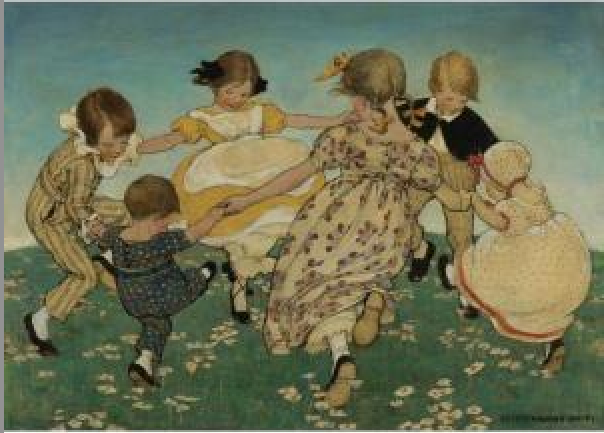April 16, 2023
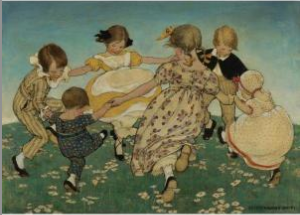
The children of my kindergarten class have loved playing circle games this year. They have played some traditional ones that involve chasing, but more often, I have exercised my creativity to make up new ones along themes they enjoy, or movements and gestures they need. I have included a few today for you to try as well!
Bulbs and Seeds
As the Spring arrived we used a well-known poem for circle game transitioning between snack time and outdoor play. It’s a lovely few moments of rest for them in the midst of this busy transition, and it incorporates important gestures of contraction and expansion.
With the children in a circle on the rug, I begin describing how a bulb will sleep in the ground, with her fresh shoots ready to poke out of the ground, and her bottom down, tucked up tight. The children try to imagine and create this with their bodies; many of them catch on and put hands together above their heads for shoots, sitting upright on their bottoms with their legs bent in front. I don’t correct anyone, instead allowing them to explore through the game whether their pose works. I tell them to stay sleeping and listen well for when they must jump out of bed. Then I begin with a soft voice…
A little brown bulb went sleep in the ground.
In his little brown nightie he slept very sound.
Old Winter he roared and he raged overhead,
But this little brown bulb did not move in his bed.
Then I take a green silk and brush it over the top of the “bulbs” heads as I continue,
But when (Lady) Spring came tiptoeing over the lea
With fingers to lips as as soft as can be,
The little brown bulb just lifted his head,
Slipped off his nightie and jumped out of bed. (A. Fairman, in “Spring,” Wynstones Press)
Naturally, the children catch on to lifting their heads and jumping up to be a flower. I ask them what kind of flower they are and to show how that flower might stand stretching its sweet face up to the sun. I ask if they noticed who got to actually jump and how that worked, so everyone is positioned more similarly at the beginning of the next time. Then I tell them that they may “jump” out of bed when Lady Spring’s magic (silk) passes over them to wake them up. We repeat it to put it all together. Sometimes, I play with everyone at once, and sometimes with just a few at a time, while all the other bulbs wait sleeping.
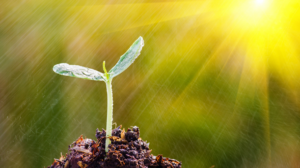 As the Spring has moved along, we shifted to another growing poem because the children loved that game so much. The first time I was the little gnome, in subsequent games two children become gnomes. In this case, the gnomes will pick a quiet seedling to help “grow” into a flower and at the end they move on together to get ready to line up for outdoors. Alternatively, the children can do the actions for themselves if we are in too silly of a mood to help each other. Again, this allows for a much-appreciated pause between activities, and movements contraction and expansion, with the addition of playful touch.
As the Spring has moved along, we shifted to another growing poem because the children loved that game so much. The first time I was the little gnome, in subsequent games two children become gnomes. In this case, the gnomes will pick a quiet seedling to help “grow” into a flower and at the end they move on together to get ready to line up for outdoors. Alternatively, the children can do the actions for themselves if we are in too silly of a mood to help each other. Again, this allows for a much-appreciated pause between activities, and movements contraction and expansion, with the addition of playful touch.
Baby seedlings wrapped up tight
In their cosy nest of night.
Gently, gently will they wake
With a little Springtime shake!
Here, I asked the children how the seedlings might rise up with a little shake. Then the “gnome” uses a bit of pressure with a downward rub from thigh to foot on each leg to “tug the roots”. Each arm is gently “stretched” upwards to become a “little shoot” with hands pressed together overhead (the flowers are asked like before how they might grow tall). Then, the “flower” opens up their hands and they bow gently to the gnome to receive a soft touch with both hands on the head.
The gnomes will tug each little root
And green will grow each little shoot
And as their lovely leaves unfold
They put on flower caps of gold.
Then we end together with…
Lady Spring, lady spring widely loving everything!
(Adapted from Lady Spring in “Spring,” Wynstones Press)
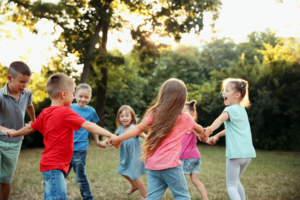
Rain is Dropping
As thunderstorms and rain visit our area, we sing “Rain is Dropping” in a circle, as we did many years ago at the Rose Rock School. Holding hands, we tiptoe inward as the “rain is dropping, then we gently expand with arms stretched wide and round like the sun on the last part of the line (and each succeeding line). As “clouds are sailing” we stand and sway our bodies and arms back and forth, and as “wind is blowing” we quickly turn in a circle, gently weaving in and out. We have a lot of moments here that insist on intentional movement- from tiptoeing slowly, walking backwards, swaying and (almost) running with the wind. We also have more contraction and expansion, as well as changes in rhythm. It is all quite fun!
Rain is dropping, rain is dropping, now the sun shines clear!
Rain is dropping, rain is dropping, now the sun shines clear!
Clouds are sailing, clouds are sailing, now the sun shines clear!
Wind is blowing, wind is blowing, now the sun shines clear!
Busy Bees
Now as the bees have arrived outdoors, we are bringing a circle game inspired by a song from “Summer,” Wynstones Press, though you could use any bee-themed song or poem. The children sit in a wide circle with bean bags scattered about inside the circle. One or two children at a time are designated as “honey bees,” and their job is to collect pieces of pollen as we sing the song twice through. We talk briefly beforehand about how bees collect their pollen in little “pockets” on their legs, and I ask the children where they might put the “pollen” as they buzz about our meadow (circle). The children often conclude on their own to tuck it under their arms or behind their knees. We try these out, and even though behind the knee doesn’t work to get anywhere, I challenge the older students to carry it between their knees. All the pollen is brought back to their hives, which are their sitting spots at the circle.
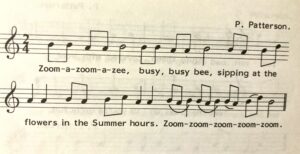
Try one or two of these with you group of children, or exercise your creativity in imagining your own!
Blessing on your work and play,

